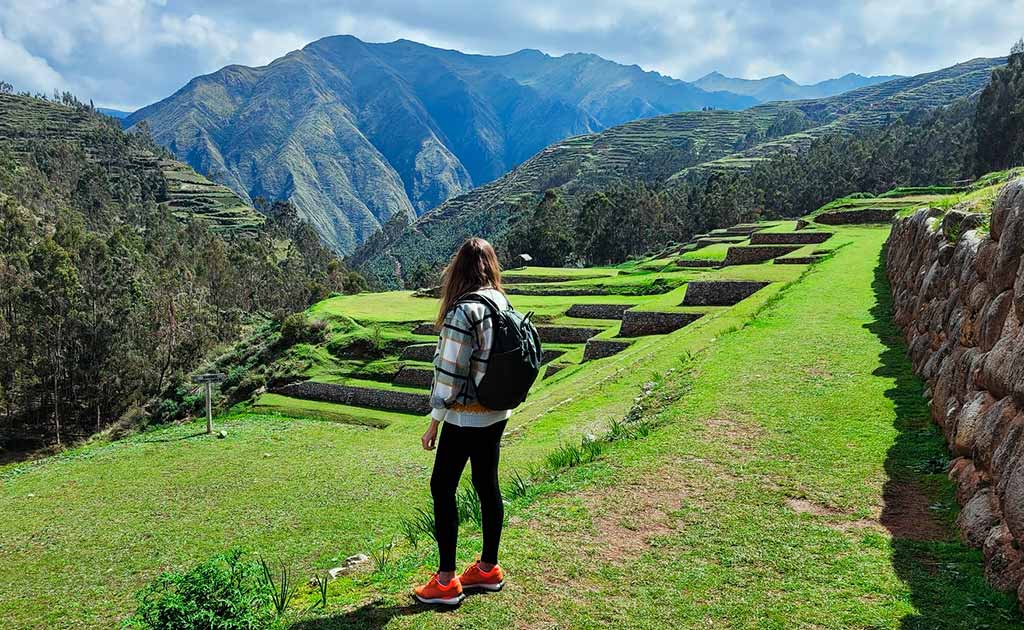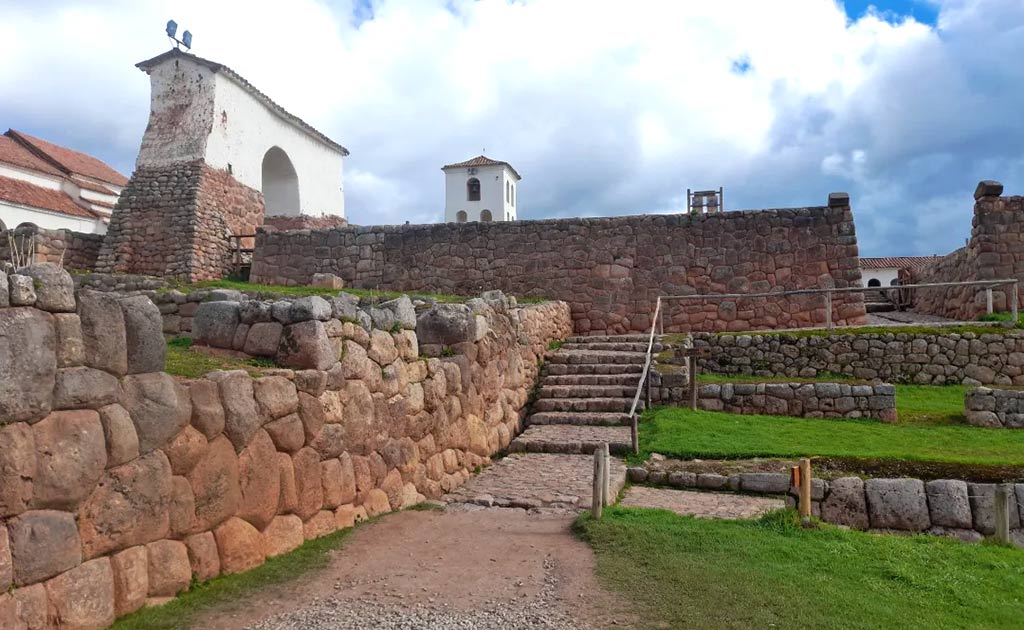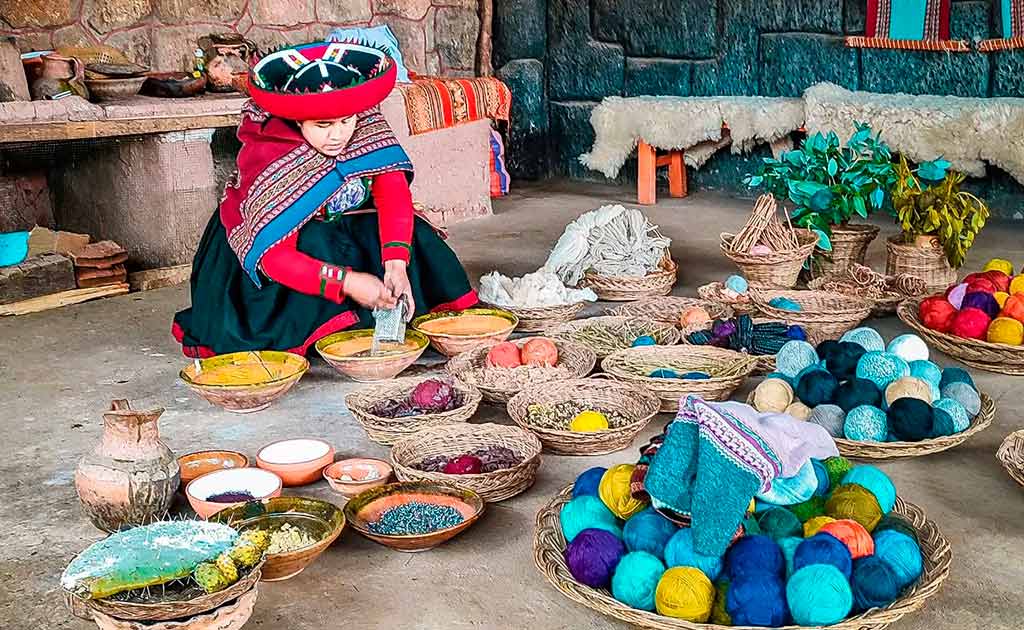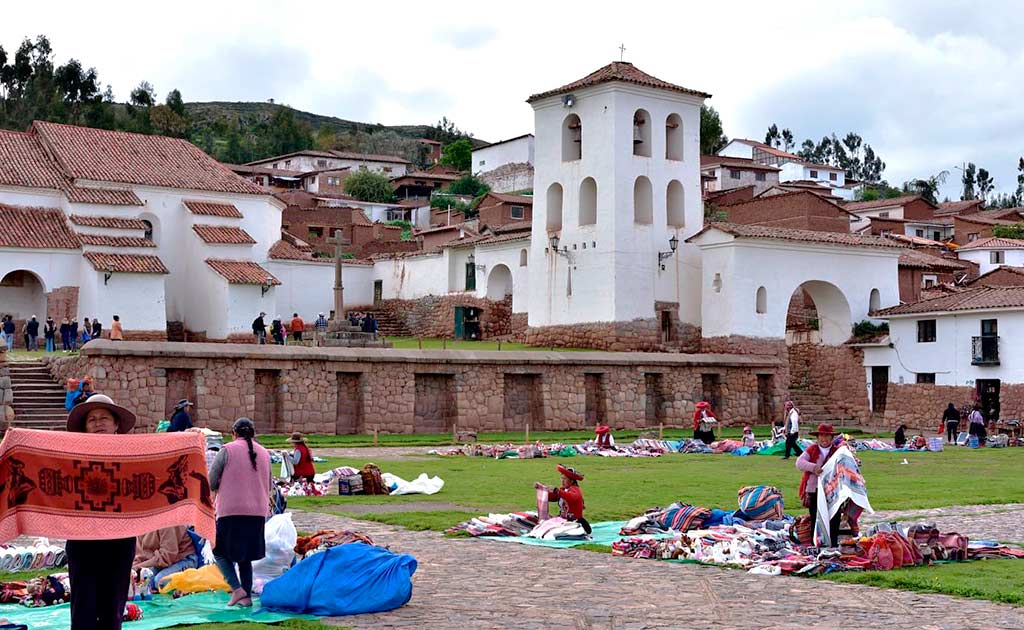May 12, 2025
Chinchero Archaeological Park
Chinchero is one of the most mystical towns you’ll find throughout the Sacred Valley of the Incas. The culture surrounding this place is among the most impressive you’ll experience during your journey, as it preserves much of the Andean tradition from pre-colonial times. Its importance also lies in being home to an architectural site, from where we can learn more about Inca history.

Contents
- What will I find in Chinchero?
- What is the Chinchero Archaeological Park like?
- Where is Chinchero?
- What to do in Chinchero?
- Tours to the Chinchero Archaeological Park
- Tips for your visit to Chinchero
- Frequently Asked Questions
What will I find in Chinchero?
Known as the rainbow town, Chinchero is a place in the Sacred Valley where you’ll be surrounded by abundant nature and ancestral culture. Through historic streets, you can discover more of the Inca legacy via its archaeological park, which stands next to the ancient palace of Túpac Yupanqui. Today, an impressive church stands on its foundations.
Chinchero is the most colorful and traditional town, where many Indigenous communities gather with ancient knowledge. Besides tourism, their main activities are agriculture, livestock, and textile weaving—each of which forms part of this magical place’s identity.
Here you can also enjoy breathtaking views of snow-capped peaks such as Salkantay, Chicón, Verónica, and Pitusiray. The entire landscape invites you to explore its mountains and green fields, where you can rest while admiring its great beauty and biodiversity.
What is the Chinchero Archaeological Park like?
Built by the Inca Túpac Yupanqui around 1493, the Chinchero Archaeological Park presents us with agricultural terraces, stone enclosures, sacred places (wacas), stone gateways, and foundations that once served as urban residential areas.
It is said that its construction was intended as a place for recreation, rest, and worship of deities such as the Sun, water, and mountains (Apus). Its total area spans 43 hectares, blending perfectly with the surrounding natural environment.
Another major attraction in the area is the colonial church of Our Lady of Monserrat, built on the foundations of the ancient palace of Túpac Yupanqui. This place also preserves a small plaza, which serves as a gathering space for the community, where, accompanied by pututus (Andean wind instruments) and in Quechua (the local native language), they discuss the most important decisions for the well-being of their culture.

Where is Chinchero?
Chinchero is located in the Sacred Valley of the Incas at an altitude of 3,762 meters above sea level, in the province of Urubamba, 30 kilometers from the city of Cusco. The approximate travel time is 1 hour through stunning landscapes.
Thanks to its geography, Chinchero is surrounded by lagoons, mountains, and snow-capped peaks. Each of these features provides a spectacular panorama, allowing us to enjoy the unmissable scenery that characterizes the valley.
What to do in Chinchero?
Chinchero is a traditional town that offers a wide variety of destinations and activities. After visiting its magnificent archaeological park and the colonial church, you can explore traditional markets where you’ll learn more about its culture.
You can also visit textile centers where you can not only purchase high-quality garments and accessories rich in tradition, but also learn about the weaving and natural dyeing techniques used by local artisans—a truly immersive experience.
Throughout Chinchero, you’ll find two famous lagoons: Piuray and Huaypo. From there, you can admire the flora and fauna that characterize the area. These routes are also great for adventure sports such as ATV rides, cycling, hiking, paragliding, and even zip-lining. The landscape provides unforgettable experiences thanks to its terrain.
Finally, don’t miss out on the local cuisine, which is one of the most distinctive in the valley. You’ll find dishes like baked guinea pig, pork cracklings, fried trout, and many more. It’s also ideal to pair them with traditional drinks like chicha (fermented corn beverage) or frutillada (a strawberry-based drink).

Tours to the Chinchero Archaeological Park
If you want to discover the magical town of Chinchero along with its impressive archaeological park, we offer tour options that will allow you to explore more destinations throughout the entire Sacred Valley of the Incas.
Classic Sacred Valley Tour (1 day)
The classic Sacred Valley tour allows us to visit the Chinchero Archaeological Park along with the Pisac archaeological center and the Ollantaytambo archaeological fortress, on a one-day trip that takes us to the main citadels and monuments of the Inca era. Additionally, the tour includes a buffet lunch in the town of Urubamba. The tour starts at 07:30 AM and ends at 06:00 PM.
VIP Sacred Valley Tour (1 day)
The second attractive option is the VIP Sacred Valley Tour which, unlike the classic tour, adds a couple of destinations to the experience, including the circular terraces of Moray and the Maras salt mines. A buffet lunch in Urubamba is also included. The trip begins at 06:40 AM and ends at 06:00 PM.
Maras and Moray Tour (2 days)
This tour offers a different route, because unlike the classic tours, we will visit lesser-known destinations that show us a different side of the Sacred Valley. First, we’ll visit the Chinchero Archaeological Park, followed by the Maras salt mines and the circular terraces of Moray. The buffet lunch is provided in the town of Urubamba. The tour starts at 06:40 AM and ends at 06:00 PM.
Tips for Your Visit to Chinchero
If you’re planning to travel to the Sacred Valley to visit Chinchero, here are some tips to make your stay more memorable. These suggestions will help you be prepared and take certain details into account.
- The Sacred Valley of the Incas is one of the best places to acclimate during your first days in Cusco, thanks to its average altitude of 2,900 meters above sea level and its mild climate.
- Take a break and relax in the town of Chinchero—it’s a magical place where every beautiful angle is worth photographing.
- Visit one of Chinchero’s textile workshops to learn about traditional weaving techniques and natural dyeing methods.
- When exploring Chinchero during the dry season (April to October), you’ll enjoy sunnier and clearer weather, but also larger crowds of tourists.
- During the rainy season (November to March), your visit to Chinchero may include more rainfall, but you’ll have the chance to explore more peacefully without heavy crowds.
- Explore Chinchero and its famous lagoons—Piuray and Huaypo—to gain a broader perspective of the region.
- Take your time visiting the Chinchero Archaeological Park so you don’t miss any details and can enjoy each of its magical structures.
- Chinchero is open every day of the year from 7:00 AM to 5:00 PM.
- To explore the Chinchero Archaeological Park without a guided tour, you’ll need to purchase the Cusco Tourist Ticket or the Ticket for Circuit 3, which also grants access to the Pisac Archaeological Center, the Ollantaytambo Fortress, and the circular terraces of Moray.
- Remember that you can plan your Sacred Valley tour and choose your own route. Talk to our advisors and discover all the options we have available for you.

Frequently Asked Questions
1. What will I find in Chinchero?
Chinchero stands out as a cultural and architectural site dating back to Inca times. It was built as a place of rest by Inca Túpac Yupanqui and today preserves agricultural terraces, ceremonial enclosures, and a colonial church built atop an ancient Inca palace.
2. How do I get to Chinchero from Cusco?
Chinchero is located 30 kilometers from Cusco, which equals approximately a one-hour journey.
3. What are the opening hours of the Chinchero Archaeological Park?
The archaeological park is open every day of the year from 7:00 AM to 5:00 PM.
4. What ticket do I need to enter the Chinchero Archaeological Park?
To enter, you need to purchase the Cusco Tourist Ticket or the partial ticket for Circuit 3, which also includes Pisac, Ollantaytambo, and Moray.
5. What activities can I do in Chinchero?
In addition to visiting the archaeological park, you can explore artisan markets, traditional textile workshops, and enjoy outdoor activities like cycling, paragliding, hiking, or visiting the Piuray and Huaypo lagoons.
6. What is the best time to visit Chinchero?
The dry season, between April and October, is ideal for its sunny days and clear skies, although it’s more crowded. During the rainy season, from November to March, there are fewer tourists, but you’re more likely to encounter rain.
7. What’s the difference between the classic and VIP Sacred Valley tours?
The classic tour includes visits to Chinchero, Pisac, and Ollantaytambo, while the VIP tour enhances the experience by adding the Maras salt mines and the circular terraces of Moray.
8. What is the experience like at the Chinchero textile workshops?
The Chinchero textile workshops are places where the community demonstrates their ancestral weaving and natural dyeing techniques. In addition to purchasing textiles, you can also take part in interactive demonstrations.
9. What landscapes will I find in Chinchero?
In Chinchero you’ll see everything from vast green agricultural fields to panoramic views of the snow-capped peaks of Salkantay, Verónica, Chicón, and Pitusiray. The Piuray and Huaypo lagoons are also notable highlights.
10. Is Chinchero accessible for all ages?
Yes, visiting the archaeological park and the town in general does not require strenuous physical effort, making it suitable for both older adults and children to explore comfortably.